A few more trunk muscles
We are no longer building saddle trees, but we have two videos about how Western saddles fit horses available on our westernsaddlefit.com website.
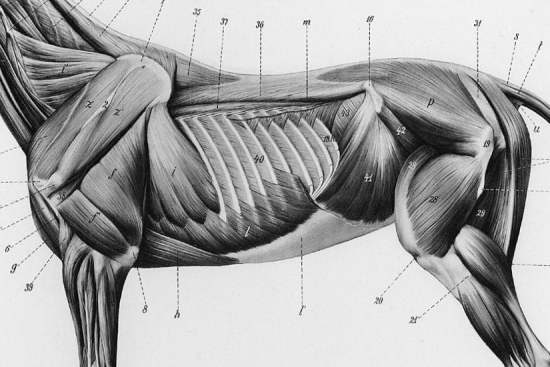
Last time I discussed the basic anatomy of the longissimus dorsi muscle. Now I need to go over the last few muscles I plan to talk about in this series. Since they work either along with, or antagonistic to, the longissimus dorsi, I figured I should go over them before I talk about movement of the spine.
A couple of segmented muscles
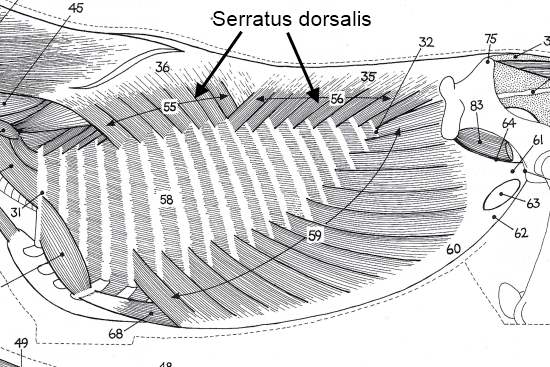
There's a couple of segmented muscles that act primarily on the ribs but which can also affect the spine. They all start on the fascia overlying the vertebrae and sometimes on vertebral transverse processes or ribs. The serratus dorsalis has two sections. The cranial (toward the head) section pulls ribs 5 (or 6) to ribs 11 (or 12) forward. The caudal (towards the tail) section pulls the last 7 or 8 ribs backwards. This helps in inspiration (cranial part) and expiration (caudal part).
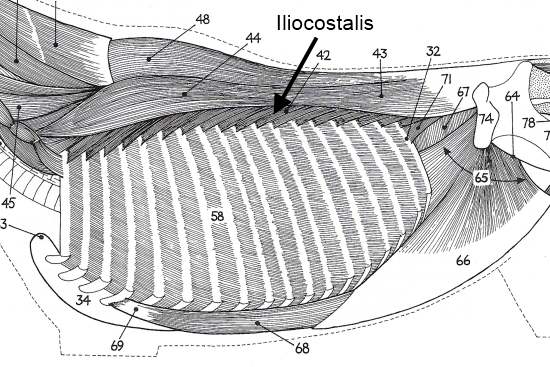
The segments of the iliocostalis all run forward and down. Some segments start way back in the lumbar area and segments continue to start all the way forward to the third rib. They insert on the lateral surfaces of the ribs and even on the last cervical vertebrae. The iliocostalis helps in expiration, since it pulls the ribs backwards, but it has more effect on the spine. Like the longissimus dorsi, if all the segments contract at once, it helps extend (hollow) the spine. If only one side all contracts at once, it assists in lateral bending. But segmented muscles don't all have to act at the same time. Usually different segments contract at different times.
You can actually feels these muscles on your horse. If you stand beside him and put your fingers on his dorsal spinous processes about the level of the last few ribs, then pull down and out lightly, you will be running your fingers over the longissimus dorsi. Out about six or eight inches or so from the spine, you kind of "bump off" the edge of the longissimus, but then there is another smaller bump of muscle before you get down onto the ribs themselves. That smaller bump is made up of the caudal serratus dorsalis and the iliocostalis muscles. How well you will feel this depends a whole lot on how much fat cover your horse has. Thinner horses are much easier to feel than fatter ones.
The multifidus muscle
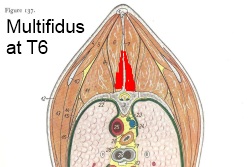 |
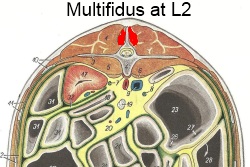 |
The multifidus is another segmented muscle which is the deepest one of them all, lying underneath the longissimus dorsi, right next to the bone. Some segments start as far back as the sacrum. Others originate on the articular processes of the lumbar vertebrae and, forward of that, from the transverse processes of the thoracic vertebrae. They run forward and upward to attach on either the tops or the sides of the dorsal spinous processes a few vertebrae ahead of where they started. Again, acting all together the multifidus would help extend the spine, but if one side only was acting, it would help to flex the spine laterally.
The sublumbar muscles
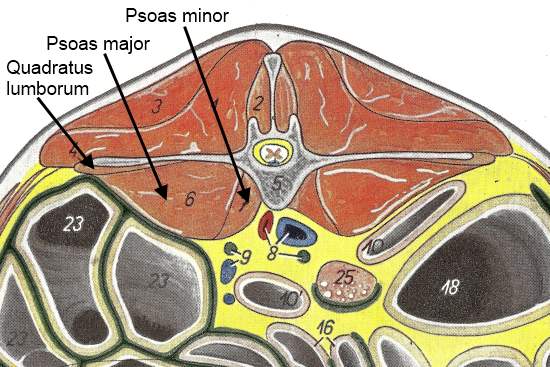
There are a few muscles underlying the vertebrae in the loin area. These are the psoas major and minor, the iliacus (the psoas major and iliacus join and are sometimes together called the iliopsoas), and the very small quadratus lumborum. These are what make up the "tenderloin" in edible animal species. They originate on the underside of the lumbar vertebrae and sometimes the last few thoracic vertebrae or ribs and insert on the pelvis or upper femur, depending on the muscle. They act basically to flex the pelvis or hip, and in doing so assist in the large amount of flexion possible at the lumbosacral junction. Because of their location, they also flex the lumbar spine a little bit (there isn't much flexion there) or bend it laterally a bit (there is even less of that motion possible) depending if both sides or just one side is contracting.
What about the thoracic spine?
On the other hand, there are no muscles underlying the first 16 or so thoracic vertebrae, yet most of the flexion and extension in the thoracolumbar spine happens in the thoracic section. If the longissimus dorsi and the other segmented muscles mentioned above all act to extend (hollow) the spine, what muscles act to flex (round) the spine there? The answer: primarily the abdominal muscles.
Abdominal muscle layers
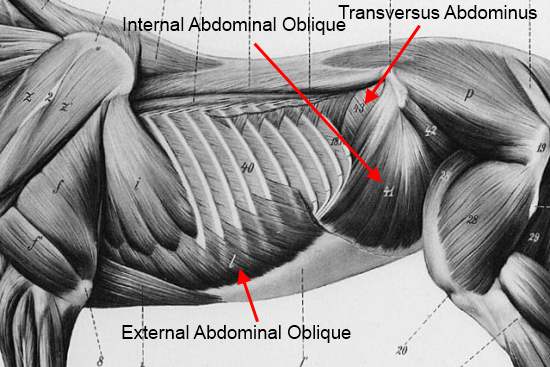
There are three layers of abdominal muscle that start on ribs, pelvis, thoracolumbar fascia and/or transverse processes of lumbar vertebrae. These wrap around the abdomen and join together along the ventral midline. The outside layer (the external abdominal oblique) runs down and back. The next layer (the internal abdominal oblique) runs down and forward. And the inside layer (the transversus abdominus), runs pretty much just down. They all insert on the linea alba which, being interpreted, means "white line". (See, I told you learning anatomy was easier when everyone spoke Latin!) This is a very strong band of white fibrous tissue made up of the flat tendons (aponeuroses) of these abdominal muscles which runs right down the center of the abdomen from sternum to pelvis. (Some of these muscles also insert a bit on the pelvis or the ribs.)
The abdominal muscles all act to hold up the abdominal contents and keep them in the abdomen. (Pretty obvious...) As they contract, they compress whatever is inside the abdomen which is helpful for expiration (you get a "heave line" at the attachment point of these muscles in "heavey" horses where the muscle gets larger due to excess use in breathing out), elimination (either kind), and for mares having foals. But "sucking in their gut" also acts to flex (arch) the spine, while contracting only one side helps with lateral flexion.
The rectus abdominis
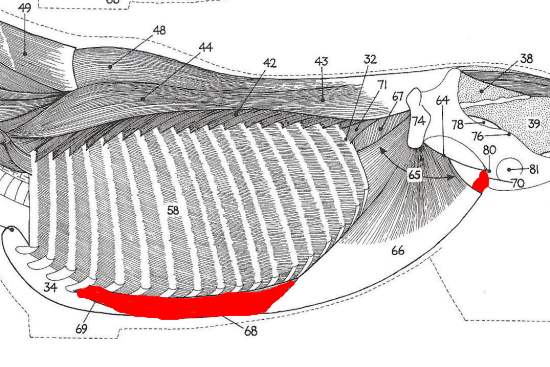
This is the muscle that makes the "six pack" in people. It starts on the sternum, along with the cartilages of ribs 4 or 5 to 9, and runs backward to the front of the pubis, which is the bone at the front of the bottom of the pelvis. When people contract their rectus abdominis, it enables them to do sit ups. When horses do their "belly lift", they are doing the same thing. Contracting the rectus abdominis results in them tilting their pelvis forward and down and flexing (rounding) the whole length of the spine, but especially the lumbosacral junction. If you had to pick one muscle that was most efficient at flexing the spine, this would be it.
So if we just went with how things look like they should work, then the longissimus dorsi, the serratus dorsalis, the iliocostalis and the multifidus should be contracting as the back extends, and the sublumbar muscles and the abdominal muscles, including the rectus abdominis, should be contracting when the back is flexing. But with the technology now available, what have they discovered about back movement and these muscles? Next time...
